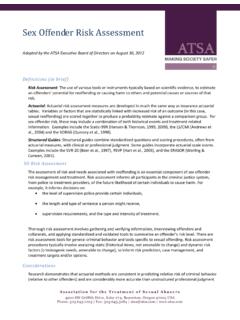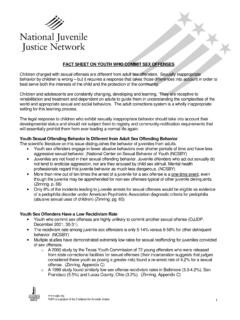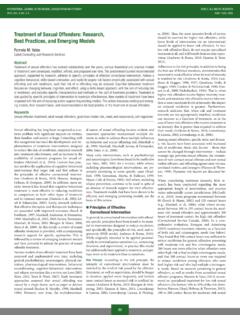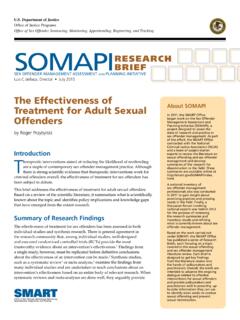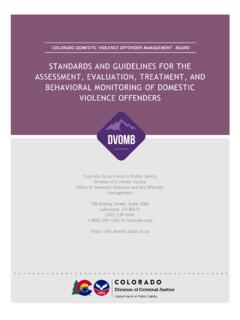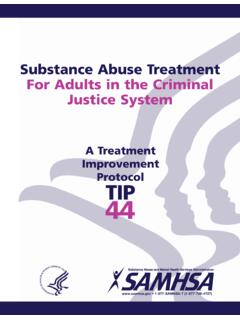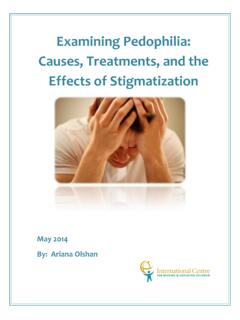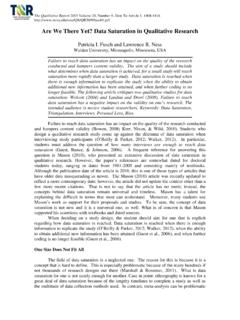Transcription of Multisystemic Therapy (MST) Overview
1 Multisystemic Therapy (MST) Overview Presented byMST ServicesRevised 11/06/14 Multisystemic Therapy (MST) Overview1 MST Research and Dissemination Family Services Research Center (FSRC) at the Medical University of South Carolina (MUSC) MST Services MST Institute Licensed and affiliated organizations:-MST Network Partner Organizations-Local MST Provider OrganizationsMultisystemic Therapy (MST) Overview2 MST Presence Around the World Australia Belgium Canada Chile Denmark England Iceland Netherlands * New Zealand Northern Ireland Norway * Scotland Sweden SwitzerlandMultisystemic Therapy (MST) Overview334 states in the US Statewide infrastructures in Connecticut, Hawaii, New Mexico, North Carolina, Ohio, Pennsylvania, and Louisiana15 countries*Nationwide infrastructures with an emerging nationwide infrastructure in EnglandWhat is MST ? Community-based, family-driven treatment for antisocial/delinquent behavior in youth Focus is on Empowering caregivers (parents) to solve current and future problems MST client is the entire ecology of the youth - family, peers, school, neighborhood Highly structured clinical supervision and quality assurance processes Multisystemic Therapy (MST) Overview4 Standard MST Referral Criteria (ages 12-17)Inclusionary Criteria Youth at risk for placement due to anti-social or delinquent behaviors, including substance abuse Youth involved with the juvenile justice system Youth who have committed sexual offenses in conjunction with other anti-social behaviorExclusionary Criteria Youth living independently Sex offending in the absence of other anti social behavior Youth with moderate to severe autism (difficulties with social communication, social interaction, and repetitive behaviors)
2 Actively homicidal, suicidal or psychotic Youth whose psychiatric problems are primary reason leading to referral, or have severe and serious psychiatric problems5 Multisystemic Therapy (MST) OverviewFamilies as the Solution MST focuses on families as the solution Families are full collaborators in treatment planning and delivery with a focus on family members as the long-term change agents Giving up on families, or labeling them as resistant or unmotivated is not an option MST has a strong track record of client engagement, retention, and satisfactionMultisystemic Therapy (MST) Overview6 MST Champions & Advocates Surgeon General: Reports on Mental Health and Youth Violence National Institutes on Health (NIH) Department of Justice - OJJDP National Institute on Drug Abuse (NIDA),Center for Substance Abuse treatment (CSAT), and Center for Substance Abuse Prevention (CSAP) Washington State Institute for Public Policy (WSIPP) Blueprints for Violence Prevention Multisystemic Therapy (MST) Overview7 Surgeon General s Reports MST is the only treatment to qualify for inclusion in the Surgeon General s Report on Mental Health under Home-Based Services.
3 (Mental Health: A Report of the Surgeon General, 1999) MST is highlighted in the Surgeon General s Report on Youth Violence as an effective treatment program for adolescent criminal offenders(Youth Violence: A Report of the Surgeon General, 2001) Multisystemic Therapy (MST) Overview8US Department of Justice - OJJDP MST offers new hope to young people with serious behavioral disorders. MST has demonstrated decreased criminal activity and incarceration in studies with violent and chronic juvenile offenders, and results are promising in studies of other populations that present complex clinical problems. (OJJDP Bulletin, 1997) Multisystemic Therapy (MST) Overview9 Preventing in Adolescents: National Institutes of Health State-of-the-Science Conference Multisystemic evaluations have demonstrated reductions in long-term rates of rearrest, violent crime arrest, and out-of-home placements. Positive results were maintained for nearly 4 years after treatment ended.
4 (NIH Preventing Violence State-of-the-Science Conference Statement, 2005) Multisystemic Therapy (MST) Overview10 MST and Substance Abuse Services National Institute of Drug Abuse Highlights MST as an effective research-based treatment program (Principles of Drug Addiction treatment : A Research-Based Guide, NIDA, 1999) Center of Substance Abuse Prevention 2000 Exemplary Substance Abuse Prevention Award Center of Substance Abuse treatment Identified as a strategy for integrating Substance Abuse treatment into the Juvenile Justice SystemMultisystemic Therapy (MST) Overview11 Cost Effectiveness of MST Washington State Institute for Public Policy (2011) Evaluating evidence-based options to reduce the future need for prison beds, save money, and lower crime rates. Estimated net taxpayers benefits for using MST in lieu of placement: $29,302/youth Benefits of $ for every $ invested in MST implementation Multisystemic Therapy (MST) Overview12 Blueprints For Violence Prevention Objective: find programs to form the nucleus of a national violence prevention initiative 11 programs have been selected to date Selection standards: strong research design, evidence of significant deterrence effects, multi-site replication, and sustained effects.
5 Comprehensive review of more that 900 programs --MST is a Blueprint for serious, violent and/or substance abusing youthMultisystemic Therapy (MST) Overview13 How Does MST Work?Key Points: Theoretical And Research Underpinnings MST Theory of Change and Assumptions How is MST Implemented? Multisystemic Therapy (MST) Overview14 Theoretical Underpinnings Children and adolescents live in a social ecology of interconnected systems that impact their behaviors in direct and indirect ways These influences act in both directions (they are reciprocal and bi-directional)Based on social ecological theory of Uri BronfenbrennerMultisystemic Therapy (MST) Overview15 Social Ecological Model CommunityProvider AgencySchoolNeighborhoodPeersExtended FamilySiblingsCHILDF amily MembersCaregiverMultisystemic Therapy (MST) Overview16 Causal Models of Delinquency and Drug Use: Common Findings of 50+ Years of ResearchFamilySchoolDelinquentPeersDelin quentBehaviorPrior DelinquentBehaviorNeighborhood/ CommunityContextMultisystemic Therapy (MST) Overview17 Research on Delinquency and Drug Use Family Level Poor parental supervision Inconsistent or lax discipline Poor affective relations between youth, caregivers, and siblings Parental substance abuse and mental health problemsMultisystemic Therapy (MST) Overview18 Research on Delinquency and Drug Use (Cont.)
6 Peer Level Association with drug-using and/or delinquent peers Poor relationship with peers, peer rejection Association with antisocial peers is the most powerful direct predictor of delinquent behavior! Multisystemic Therapy (MST) Overview19 Research on Delinquency and Drug Use (Cont.)School Level Academic difficulties, low grades, having been retained Behavioral problems at school, truancy, suspensions Negative attitude toward school Attending a school that does not flex to youth needsMultisystemic Therapy (MST) Overview20 Research on Delinquency and Drug Use (Cont.)Community Level Availability of weapons and drugs High environmental and psychosocial stress (violence) Neighborhood transience neighbors move in and outMultisystemic Therapy (MST) Overview21 Research on Delinquency and Drug Use (Cont.) Youth Level ADHD, impulsivity Positive attitude toward delinquency and substance use Lack of guilt for transgressions Negative affectMultisystemic Therapy (MST) Overview22 MST Theory of ChangeMultisystemic Therapy (MST) OverviewMSTI mproved Family FunctioningPeers SchoolReduced Antisocial Behavior and Improved FunctioningCommunity23 MST Assumptions Children s behavior is strongly influenced by their families, friends and communities (and vice versa) Families and communities are central and essential partners and collaborators in MST treatment Caregivers/parents want the best for their children and want them to grow to become productive adultsMultisystemic Therapy (MST) Overview24 MST Assumptions (Cont.)
7 Families can live successfully without formal, mandated services Change can occur quickly Professional treatment providers should be accountable for achieving outcomes Science/research provides valuable guidanceMultisystemic Therapy (MST) Overview25 How is MST Implemented?Intervention strategies: MST draws from research-based treatment techniques Behavior Therapy Parent management training Cognitive behavior Therapy Pragmatic family therapies-Structural Family Therapy -Strategic Family Therapy Pharmacological interventions ( , for ADHD) Multisystemic Therapy (MST) Overview26 How is MST Implemented?(Cont.) Single therapist working intensively with 4 to 6 families at a time Team of 2 to 4 therapists plus a supervisor 24 hr/ 7 day/ week team availability: on call system 3 to 5 months is the typical treatment time (4 months on average across cases) Work is done in the community, home, school, neighborhood: removes barriers to service access Multisystemic Therapy (MST) Overview27 How is MST Implemented?
8 (Cont.) MST staff deliver all treatment typically no or few services are brokered/referred outside the MST team Never-ending focus on engagement and alignment with primary caregiver and other key stakeholders ( probation, courts, children and family services, etc.) MST has strong track record of client retention and satisfaction with MST MST staff must be able to have a lead clinical role, ensuring services are individualized to strengths and needs of each youth/familyMultisystemic Therapy (MST) Overview28 Quality Assurance and Continuous Quality Improvement in MSTGoal of MST Implementation: Obtain positive outcomes for MST youth and their familiesQA/QI Process: Training and ongoing support (orientation training, boosters, weekly expert consultation, weekly supervision) Organizational support for MST programs Implementation monitoring (measure adherence and outcomes, work sample reviews) Improve MST implementation as needed, using feedback from training, ongoing support, and measurement29 Multisystemic Therapy (MST) OverviewQA/QI Process.
9 Training and Support Training and support to help therapists, supervisors, and experts implement the model as designed Training processes (5-day Orientation, Supervisor Orientation, Boosters, Consultation, Group Supervision, and additional supervision and feedback for all staff as needed) Training materials (MST text, 5-day training materials, Supervisory Manual, Supervisor Orientation materials, and Consultation Manual)30 Multisystemic Therapy (MST) OverviewQA/QI Process: Organizational Support for MST Programs Training resources and materials in organizational practices that support MST Program Developer Training Organizational Manual Implement organizational practices needed to support delivery of the treatment model MST Program Development Method Ongoing problem solving of organizational and stakeholder barriers to implementation31 Multisystemic Therapy (MST) OverviewQA/QI Process: Monitor Implementation of the Model Measure Adherence to the Model Adherence measures entered and monitored via the MSTI Website (TAM-R, SAM, CAM, Program Review Form) Work sample review ( session recordings and field visits, group supervision recordings) Measure Outcomes Discharge Review Form data entered and monitored via the MSTI Website32 MST Therapists' Role in Continuous Quality ImprovementQA/QI Process.
10 Improve Implementation of MST as Needed Improve implementation as needed, based on the information provided via measurement of adherence, outcomes, and staff s strengths and needs Group supervision, consultation, and additional supervision and feedback as needed Program Implementation Review Professional development planning Follow an ongoing cycle of utilizing trainings and materials to guide implementation, measuring, and improving implementation33 MST Expert/ConsultantTA MTherapistAdherenceMeasureCAMC onsultantAdherenceMeasurePIRP rogram Implementation Review and other reportsSAM SupervisorAdherenceMeasureMST CoachInput/feedback via internet based data collection Training/support, including MST manuals/materialsMST QA/QI OverviewOutput to MST CoachOutput to MST ExpertOutput to MST Supervisor and MST ExpertOutput to Organization, Program Stakeholders and MST CoachMST SupervisorMST TherapistYo u t h /FamilyOrganizational ContextMST Quality Assurance SystemResearch-based adherence measures: TAM youth criminal charges 36% lower for families with maximum adherence score (1) than for families with minimum adherence score (0) SAM youth criminal charges 53% lower for families with maximum SAMSP score (1) than for families with minimum SAMSP score (0) CAM consultant/MST expert adherence predicts improved therapist adherence and improved youth outcomesMultisystemic Therapy (MST) OverviewMST Transportability Study: Relationship between TAM-R and Youth Criminal Outcomes ( year follow-up)TAM-R Predicting Post- treatment Criminal Charges0 (Min.)
